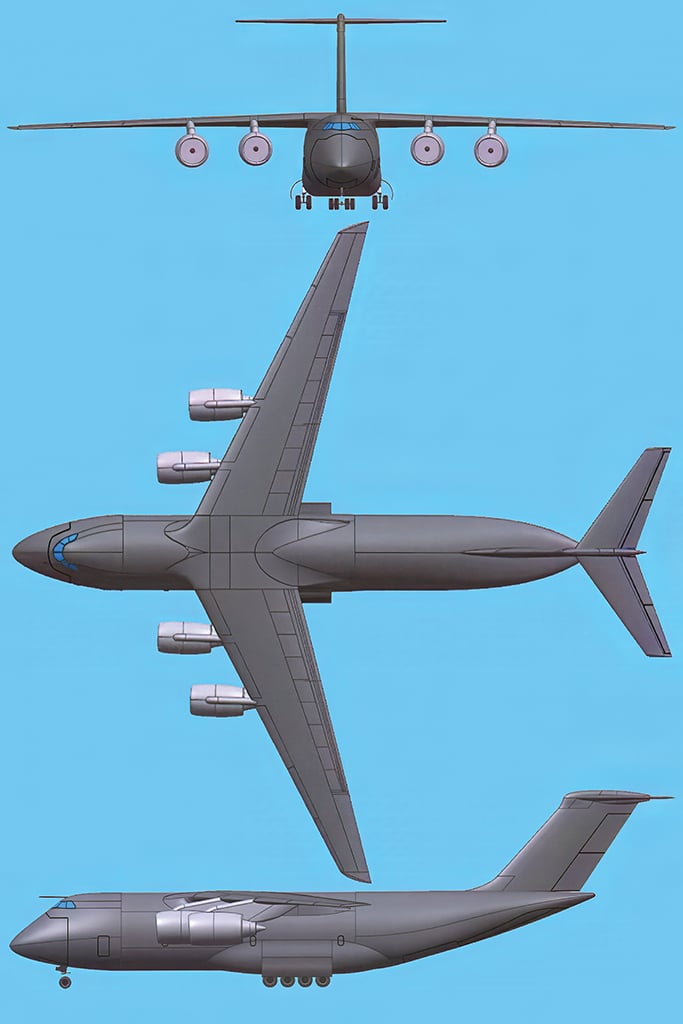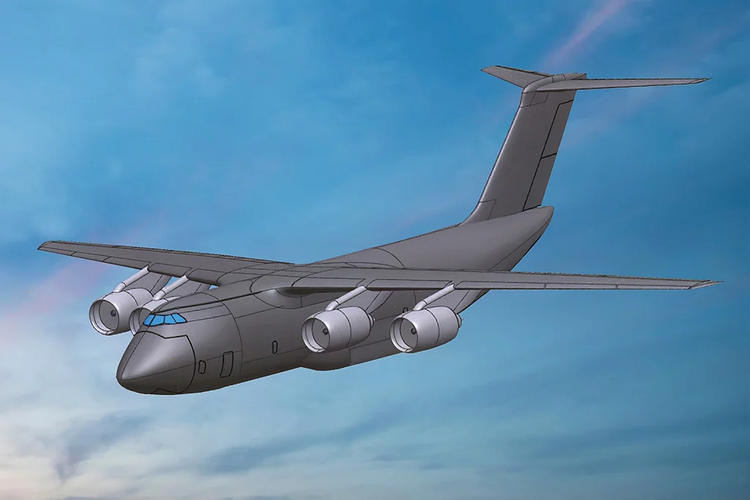flateric said:This is not Ermak
Models of Volga-Dnepr Group transport aircraft design concepts and not Ilyushin Il-106 "Ermak" concepts?
flateric said:This is not Ermak
VOLGA-DNEPR, Russia’s biggest cargo airline – and a world leader in the airfreighting of out-of-gauge and heavyweight shipments – believes this (above) could be the eventual replacement for the iconic An-124 freighter family, writes Nigel Tomkins.
The company is not only devising technical specifications for the modernisation and continuation of its existing fleet of Antonov An-124-100 airlifters, but is also investigating the creation of a new future replacement for the super heavy cargo transporter, as these design images show.
The new heavy airfreighter would be 35 to 40 per cent more efficient than the An-124, both technically and economically.
The future big and heavy airfreight market will need an aircraft with a minimum 150-to-170-tonne payload – and a range of up to to 10,000 kilometres, enabling it to perform a commercial non-stop flight across the Pacific Ocean, for example.
By comparison, the current commercial range of a fully loaded An-124-100 (with maximum payload of 120 tonnes) is 4500 km.
The specialist carrier currently operates 12 An-124-100s – the commercial version of the An-124 Ruslan military aircraft – and the world’s largest production aircraft.
Facing the need to continuously maintain the airworthiness of these 40-year-old cargo jets, whilst also regularly upgrading them to meet new ICAO and other international requirements, Volga-Dnepr’s analysts say the An-124-100 will be obsolete by 2040, forcing the company to cease the aircraft’s operations and replace them with something else.
The search for a heavyweight replacement is a top priority
That makes the search for an advanced super capable aircraft a top priority for the airline.
“The aircraft that will eventually replace the Ruslan should be something revolutionary, new and more capable by any definition,” Victor Tolmachev, the An-124’s legendary chief designer and, as of today, technical director of Volga-Dnepr has revealed to influential air transport information source Russian Aviation Insider.
According to both Tolmachev, and to an evaluation provided by Ernst & Young, in order to stay in the oversized and super heavy cargo transportation business – and even more so to be able to grow it – the company will need 40 to 100 of the new airfreighters.
“The rising markets of airspace, mining and oil industries indicate that the demand for oversized and super heavyweight transport services will do nothing but grow,” Mikhail Smirnykh, Volga-Dnepr’s CEO, told Russian Aviation Insider at the latest MAKS-2017 airshow.
That is why providing specialist shipping services for the aerospace and aviation sector, for example, remains a primary focus for the company. “We have long-term contracts with the industry’s main players, such as Boeing, Airbus, Rolls-Royce, Spirit and others.
“Remarkably, in the January-May 2017 period, the An-24-100 airspace cargo sector grew by 23 per cent year-on-year,” he revealed.
With the projected future market growth and an expanding global presence, and based on its own operational expertise and customer service experience, Volga-Dnepr has come up with a set of minimum requirements that the new super heavyweight airlifter should satisfy.
Tolmachev stresses that the future airlifter should be designed to comply with ICAO requirements up to the year 2060. The aircraft will have 100 per cent automated flight functionality and will require new and more fuel-efficient powerplants compared to the Ruslan’s D-18 engines.
“In the 1970-80s, the D-18 was a highly advanced engine offering great potential. But now we need a powerplant to live up to 2040-2060 expectations and standards. That is compelling us to consider all possible options that both the Russian and the global aviation industry can offer. Roughly, the new engine should resemble the Boeing 747-8’s GEnx-2B67 – but outperform it,” Tolmachev explains.
According to Volga-Dnepr’s technical director, neither Russian, nor foreign aircraft manufacturers, currently have on their drawing boards a viable project of a supersize, heavyweight air freighter that would even come close to matching the An-124’s performance levels. To make this future aircraft a reality, its design should start now, so that the initial serial-number airlifters could stay in service until 2070 and be actively operated during the 2060s.
“Such complicated technical and economic tasks cannot be accomplished alone. They require that companies and public authorities get together and unite their efforts in searching for the right solution,” Tolmachev adds.
The cargo airline is always striving to enhance the availability of its oversized cargo services, CEO Smirnykh points out. By the end of 2017 Volga-Dnepr will have launched five operational bases across the globe, namely at Hanoi (Vietnam), London (UK), Leipzig (Germany), Huston (USA) and Sharjah (UEA).
Each of the hubs will offer maximum competence in its ability to serve customer needs in the best possible way. Therefore the Russian carrier is looking to perform light maintenance checks on all its aircraft locally, thereby cutting down the number of costly ferry flights, whilst also improving on the image of the reliability of services in south-east Asia, the USA, the UAE and Europe.
Boris Rybak, head of Russia’s Infomost Consulting company, endorses the words of the An-124’s chief designer by saying that the new super heavy cargo aircraft will most likely be created by an international conglomerate.
“Nowadays, the needs of a single state, no matter how big it is, are not able to generate the demand that would be sufficient enough to pay back the investments.
“In this case, it would be prudent to combine the technical and project designing competence of western countries (probably the United States) with the unique experience of the Russian carrier in operating various types of cargo aircraft including ramp types.
“Volga-Dnepr has managed to build up a unique background in the sphere of air logistics which will definitely help in drafting the list of precise technical requirements for the new super heavy airlifter,” he says.
TsAGI has designed the concept of the airlifter and its construction. The next stage was the production of the model of the following size - 1.63 meters in length, wingspan of 1.75 meters, height - 0.5 meters.
Most of it is made of aluminum alloys while stressed elements are made of steel. The weight is acceptable for trials in various wind tunnels (maximum weight is 120 kg).
The model has an uninterrupted wing with dismountable stubs, the fuselage, horizontal fins with declinable two-section elevating rudders, vertical fins with two-section guidance rudders, engine nacelles with pylons and landing gear spat.
"The production of Slon heavy airlifter model was done by stages on digital precision tools. The most intensive was the wing work which has a sophisticated spatial form to ensure high aerodynamic characteristics at cruising regimes," deputy head of the technological department of the institute Andrey Sidorov said.
The model is transformable and can be tested in various configurations. The technological split of the model provides major possibilities to modify the elements of the aerodynamic design, including a change of the front and tail of the fuselage, wing stubs and landing gear spat.
The Slon model will soon be tested in T-106 wind tunnel of variable density. The institute will study its aerodynamic characteristics at cruising regimes. In 2020, Slon tests will continue in T-106 and T-102 tunnels to study aerodynamics at takeoff and landing regimes. The flowing of the model will be visualized.
Slon is to replace An-124 airlifter. It can carry large cargoes to 7000 km at a speed of 850 km/h. Maximum commercial payload is 180 tons (An-124 - 120 tons). The airstrip has to be three kilometers long. Slon is to be powered by Russian PD-35 engines. - Air Recognition

It seems to be, that the Myasishchev aircraft project M-60BT(M) (or M-60PVTS) has been proposed as part of the PAK VTA program. But IMHO the future PAK VTA will look more like an An-124.
Source (Russian): https://aviation21.ru/pak-vta-tyazhyolyj-transportnyj-samolyot-s-fyuzelyazhem-ovalnogo-secheniya/

Russia Pursues Development Of New Military Transport Aircraft
Russia Pursues Development Of New Military Transport Aircraft | Aviation Week Network
The Russian defense ministry has contracted the development of new Ilyushin Il-100 super-heavy transport.aviationweek.com


Would it be a Chinese design, the social media all over would once again call it a copy!
112 had two major problems: it was overweight (which, allegedly was solved and next test plane supposed to be less heavy) and the second being overtuned TV7-117ST engines. Russia lacks new turboprop engines with power over 3k hp, so they tuned TV7-117. Looks like TV7-117 allegedly also recieved cerification in 2023, but that's likely less powerful and throttled variants for TVRS-44 and Il-114. But there are mentions that 114 production is moving 1 year forward (it was planned this year, but some sources say it will start in 2025), so there might be some teething issues, though it may not concern engine.Thanks for the info, but besides a surely existing requirement, how likely and realistic is it to ever materialise?
As such, pardon to be again the one who ruins the party, but they so far didn't get the much smaller and simpler Il-112 ready and now such a monster without an engine available??
was not [solved]it was overweight (which, allegedly was solved and next test plane supposed to be less heavy)
Hard to guess.Thanks for the info, but besides a surely existing requirement, how likely and realistic is it to ever materialise?
As such, pardon to be again the one who ruins the party, but they so far didn't get the much smaller and simpler Il-112 ready and now such a monster without an engine available??
Where did you pick up this BS?Superjet 100 was sold to Markab Capital Investments in 2023, the parts fabrication plants in Mexico were shut down the same year.
Comac dissolved the partnership with Russia in August 2023 and said it was going back to the design board.
MC-21 has had numerous design changes and alteration to materials since the first prototypes were completed (which experienced wing box cracking) and first deliveries not using old stocks of foreign parts and PW1000G engines not now expected until 2027-2030.
They even proposed to restart mass production of legacy Tu-204/214 and IL-96.
Frankly if you dont think Russian commercial aircraft production is a shambles you are deluded.
